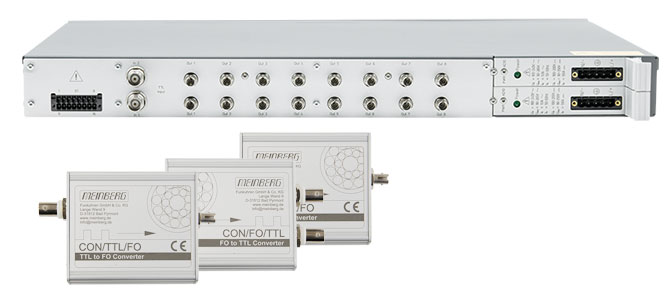Signal Distribution and Signal Converter
Meinberg offers a wide range of signal distribution systems. Among them are signal distributors in space-saving 19 inch / 1U housings with up to 24 outputs and signal distributors in 19 inch / 3U subracks (BGT), which can be equipped with up to 64 outputs. In addition to our server rack mount devices, we also offer a variety of converters and signal distributors in space-saving DIN rail housings.

Signal distribution and signal conversion
Meinberg offers a wide range of signal distribution systems. These include signal distributors in space-saving 19-inch / 1U housings with up to 24 outputs and signal distributors in 19-inch / 3U subracks (BGT), which can be equipped with up to 64 outputs. In addition to our server rack-mounted devices, we also offer a wide range of converters and signal distributors in space-saving top-hat rail housings.Digital signals (TTL, DCLS time codes such as IRIG, AFNOR ...), fibre-optic signals (via optical fibres), telecom references (E1) and analogue signals, such as amplitude-modulated time codes and low-phase noise frequencies, are distributed or converted using an SDU-R or several LNO modules in a signal distribution unit.
Our signal distribution systems enable the multiplication and distribution of a signal from a stable and highly accurate source to a large number of devices - even over long distances (multimode and single-mode fibre converters).
TTL / sine wave signal distribution:
TTL signal distribution, simple distribution and multiplexing of TTL signals with Meinberg TTL signal distributors.
Fibre optic converters and diplexers
The MEINBERG fibre optic converters convert an electrical input signal into one or more optical output signals or an FO input signal into one or more electrical output signals. Our converters are ideal for distributing signals such as IRIG (AM / DCLS), PPS or RS232 over long distances.
Redundant signal distributor
Various switching modes (auto/manual) can be selected using switches on the front panel (RSC switching unit). In automatic mode, the two signal inputs are monitored and switched over by an internal switching logic. Switching takes place in the event of signal loss at the input socket or when an error in the master system is indicated at the error input. In manual mode, the selected input is switched through directly to the outputs.
Overview Signal Distribution Units
- SDU/TTL
Signal Distribution Unit

Signal distributor for PPS, 10 MHz and IRIG. Simply expanding existing devices with additional outputs is no problem with the Meinberg SDU. - SDU/SIN:
Sine Signal Distribution Unit

Signal Distribution Unit - 1-25 MHz sine wave distributor for 19-inch rack - SDU-R
Redundant Sine or TTL Distribution

The SDU-R is a distribution unit for providing sine signals with low additive phase noise, TTL output signals via BNC sockets or fibre optic signals via F-ST connections. - Fibre Optic Converter

Fibre optic converters and diplexers: Signal distribution for long fibre optic cable runs


